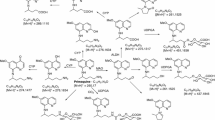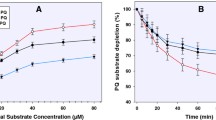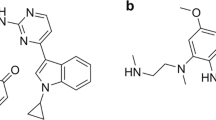Abstract
Objective
To study the extent of in vivo inhibition by the antimalarial drug amodiaquine, its active metabolite N-desethylamodiaquine, or both, of the metabolism of four probe drugs of the enzymes CYP2D6, CYP2C19, CYP2C9 and CYP1A2.
Methods
Twelve healthy Swedish volunteers received a cocktail of four probe drugs (debrisoquine, omeprazole, losartan and caffeine) to determine their baseline metabolic capacities. After a washout period, they received a 600 mg oral dose of amodiaquine hydrochloride; and 2–3 h later the cocktail was administered again. One week after the intake of amodiaquine, the subjects received the cocktail a third time. The levels of probe drugs and their metabolites as well as amodiaquine and its metabolite were determined by HPLC.
Results
Plasma levels of amodiaquine and N-desethylamodiaquine could be followed in all subjects for 6 h and 28 days, respectively. Among the 12 subjects, a 3-fold variation in amodiaquine AUC and a 2-fold variation in N-desethylamodiaquine AUC, were observed. The CYP2D6 and CYP2C9 activities of the subjects were measured by debrisoquine and losartan phenotyping tests, respectively. There were significant mean increases in debrisoquine metabolic ratio (MR) between baseline and the second cocktail [MR2 h−MRbaseline 1.426 (95% confidence interval 1.159, 1.755), P=0.002; ANOVA, Fisher LSD test] and in mean losartan MR between baseline and the second cocktail [MR2 h−MRbaseline 1.724 (95% confidence interval 1.076, 2.762), P=0.026; ANOVA, Fisher LSD test]. The effects on CYP2D6 and CYP2C9 activities subsided within a week after intake of amodiaquine as tested by the phenotyping cocktail. The changes in omeprazole MRs and caffeine MRs were not statistically significant between any of the study phases.
Conclusion
A single dose of amodiaquine decreased CYP2D6 and CYP2C9 activities significantly compared to baseline values. Amodiaquine has the potential to cause drug-drug interactions and should be further investigated in malarial patients treated with drug combinations containing amodiaquine.


Similar content being viewed by others
References
WHO (2000) WHO expert committee on malaria. WHO Tech Rep Series 892:1–74
World Health Report 2001 WHO (2001)
Kitua AY (1999) Antimalarial drug policy: making systematic change. Lancet 354(Suppl):SIV32
WHO (2001) WHO/CDS/RBM/2001.35, WHO. Antimalarial drug combination therapy. Report of a WHO technical consultation
EANMAT (2003) The efficacy of antimalarial monotherapies, sulphadoxine-pyrimethamine and amodiaquine in East Africa: implications for sub-regional policy. Trop Med Int Health 8:860–867
Olliaro P, Nevill C, LeBras J, Ringwald P, Mussano P, Garner P, Brasseur P (1996) Systematic review of amodiaquine treatment in uncomplicated malaria. Lancet 348:1196–1201
Bapiro TE, Egnell AC, Hasler JA, Masimirembwa CM (2001) Application of higher throughput screening (HTS) inhibition assays to evaluate the interaction of antiparasitic drugs with cytochrome P450s. Drug Metab Dispos 29:30–35
Makanjuola RO, Dixon PA, Oforah E (1988) Effects of antimalarial agents on plasma levels of chlorpromazine and its metabolites in schizophrenic patients. Trop Geogr Med 40:31–33
Muralidharan G, Cooper JK, Hawes EM, Korchinski ED, Midha KK (1996) Quinidine inhibits the 7-hydroxylation of chlorpromazine in extensive metabolisers of debrisoquine. Eur J Clin Pharmacol 50:121–128
Christensen M, Andersson K, Dalen P, Mirghani RA, Muirhead GJ, Nordmark A, Tybring G, Wahlberg A, Yasar U, Bertilsson L (2003) The Karolinska cocktail for phenotyping of five human cytochrome P450 enzymes. Clin Pharmacol Ther 73:517–528
Minzi OM, Rais M, Svensson JO, Gustafsson LL, Ericsson O (2003) High-performance liquid chromatographic method for determination of amodiaquine, chloroquine and their monodesethyl metabolites in biological samples. J Chromatogr B Anal Technol Biomed Life Sci 783:473–480
Svensson JO, Bertilsson L (1999) Rapid high-performance liquid chromatographic method for determination of debrisoquine and 4-hydroxy-debrisoquine in urine for CYP2D6 phenotyping. Pharmacogenetics 9:529–531
Lagerstrom PO, Persson BA (1984) Determination of omeprazole and metabolites in plasma and urine by liquid chromatography. J Chromatogr 309:347–356
Chang M, Dahl ML, Tybring G, Gotharson E, Bertilsson L (1995) Use of omeprazole as a probe drug for CYP2C19 phenotype in Swedish Caucasians: comparison with S-mephenytoin hydroxylation phenotype and CYP2C19 genotype. Pharmacogenetics 5:358–363
Ritter MA, Furtek CI, Lo MW (1997) An improved method for the simultaneous determination of losartan and its major metabolite, EXP3174, in human plasma and urine by high-performance liquid chromatography with fluorescence detection. J Pharm Biomed Anal 15:1021–1029
Yasar U, Dahl ML, Christensen M, Eliasson E (2002) Intra-individual variability in urinary losartan oxidation ratio, an in vivo marker of CYP2C9 activity. Br J Clin Pharmacol 54:183–185
Christensen M, Tybring G, Mihara K, Yasui-Furokori N, Carrillo JA, Ramos SI, Andersson K, Dahl ML, Bertilsson L (2002) Low daily 10-mg and 20-mg doses of fluvoxamine inhibit the metabolism of both caffeine (cytochrome P4501A2) and omeprazole (cytochrome P4502C19). Clin Pharmacol Ther 71:141–152
Wennerholm A, Johansson I, Massele AY, Jande M, Alm C, Aden-Abdi Y, Dahl ML, Ingelman-Sundberg M, Bertilsson L, Gustafsson LL (1999) Decreased capacity for debrisoquine metabolism among black Tanzanians: analyses of the CYP2D6 genotype and phenotype. Pharmacogenetics 9:707–714
Wennerholm A, Dandara C, Sayi J, Svensson JO, Abdi YA, Ingelman-Sundberg M, Bertilsson L, Hasler J, Gustafsson LL (2002) The African-specific CYP2D617 allele encodes an enzyme with changed substrate specificity. Clin Pharmacol Ther 71:77–88
de Morais SM, Wilkinson GR, Blaisdell J, Nakamura K, Meyer UA, Goldstein JA (1994) The major genetic defect responsible for the polymorphism of S-mephenytoin metabolism in humans. J Biol Chem 269:15419–15422
Yasar U, Eliasson E, Dahl ML, Johansson I, Ingelman-Sundberg M, Sjoqvist F (1999) Validation of methods for CYP2C9 genotyping: frequencies of mutant alleles in a Swedish population. Biochem Biophys Res Commun 254:628–631
Winstanley P, Edwards G, Orme M, Breckenridge A (1987) The disposition of amodiaquine in man after oral administration: effect of dose size on amodiaquine pharmacokinetics after oral administration. Br J Clin Pharmacol 23:1–7
Pussard E, Verdier F, Faurisson F, Scherrmann JM, Le Bras J, Blayo MC (1987) Disposition of monodesethylamodiaquine after a single oral dose of amodiaquine and three regimens for prophylaxis against Plasmodium falciparum malaria. Eur J Clin Pharmacol 33:409–414
Yue QY, Zhong ZH, Tybring G, Dalen P, Dahl ML, Bertilsson L, Sjoqvist F (1998) Pharmacokinetics of nortriptyline and its 10-hydroxy metabolite in Chinese subjects of different CYP2D6 genotypes. Clin Pharmacol Ther 64:384–390
Griese EU, Zanger UM, Brudermanns U, Gaedigk A, Mikus G, Morike K, Stuven T, Eichelbaum M (1998) Assessment of the predictive power of genotypes for the in-vivo catalytic function of CYP2D6 in a German population. Pharmacogenetics 8:15–26
Griese EU, Asante-Poku S, Ofori-Adjei D, Mikus G, Eichelbaum M (1999) Analysis of the CYP2D6 gene mutations and their consequences for enzyme function in a West African population. Pharmacogenetics 9:715–723
Farrell GC (1987) Drug metabolism in extrahepatic diseases. Pharmacol Ther 35:375–404
Abdel-Razzak Z, Loyer P, Fautrel A, Gautier JC, Corcos L, Turlin B, Beaune P, Guillouzo A (1993) Cytokines down-regulate expression of major cytochrome P-450 enzymes in adult human hepatocytes in primary culture. Mol Pharmacol 44:707–715
Phillips-Howard PA, West LJ (1990) Serious adverse drug reactions to pyrimethamine-sulphadoxine, pyrimethamine-dapsone and to amodiaquine in Britain. J R Soc Med 83:82–85
Baune B, Furlan V, Taburet AM, Farinotti R (1999) Effect of selected antimalarial drugs and inhibitors of cytochrome P-450 3A4 on halofantrine metabolism by human liver microsomes. Drug Metab Dispos 27:565–568
Kenworthy KE, Bloomer JC, Clarke SE, Houston JB (1999) CYP3A4 drug interactions: correlation of 10 in vitro probe substrates. Br J Clin Pharmacol 48:716–727
Kenworthy KE, Clarke SE, Andrews J, Houston JB (2001) Multisite kinetic models for CYP3A4: simultaneous activation and inhibition of diazepam and testosterone metabolism. Drug Metab Dispos 29:1644–1651
Nebert DW, Jorge-Nebert LF (2002) Pharmacognetics and pharmacogenomics. In: Rimoin DL, Connor JM, Pyeritz RE, Korf BR (eds) Emery and Rimoin’s principles and practice of medical genetics, 4th edn. Harcourt Brace, Edinburgh, pp 590–631
NEDLIT (1991) Standard Treatment Guidelines and the National Essential Drugs List for Tanzania (NEDLIT), Ministry of Health, United Republic of Tanzania
Adedoyin A, Frye RF, Mauro K, Branch RA (1998) Chloroquine modulation of specific metabolizing enzymes activities: investigation with selective five drug cocktail. Br J Clin Pharmacol 46:215–219
Steiner E, Dumont E, Spina E, Dahlqvist R (1988) Inhibition of desipramine 2-hydroxylation by quinidine and quinine. Clin Pharmacol Ther 43:577–581
Simooya OO, Sijumbil G, Lennard MS, Tucker GT (1998) Halofantrine and chloroquine inhibit CYP2D6 activity in healthy Zambians. Br J Clin Pharmacol 45:315–317
Acknowledgements
We gratefully acknowledge the work done by the research nurse Susann Schrey, Magnus Christensen, MD, and technician Lilleba Bohman for genotyping assays, as well as MSc Mia Sandberg, MSc Tommy Pettersson, MSc Annika Allqvist and technician Ulla Petterson for assistance with analytical assays. This work was supported by the Swedish Medical Research Council (3902), National Institutes of Health, USA (grant R01 GM60548-3), the Swedish Agency for Research Collaboration with Developing Countries (SAREC) at the Swedish International Development Cooperation Agency (SIDA) (SWE-1999-260, 99-266 Bil. Th. 106, SWE-2000-175 and SWE-2002-063), Karolinska Institute (postgraduate studentship) and the Swedish Society for Medical Research (research grants for PhD student No. A200100225 and A200300875).
Author information
Authors and Affiliations
Corresponding author
Rights and permissions
About this article
Cite this article
Wennerholm, A., Nordmark, A., Pihlsgård, M. et al. Amodiaquine, its desethylated metabolite, or both, inhibit the metabolism of debrisoquine (CYP2D6) and losartan (CYP2C9) in vivo. Eur J Clin Pharmacol 62, 539–546 (2006). https://doi.org/10.1007/s00228-006-0121-3
Received:
Accepted:
Published:
Issue Date:
DOI: https://doi.org/10.1007/s00228-006-0121-3




